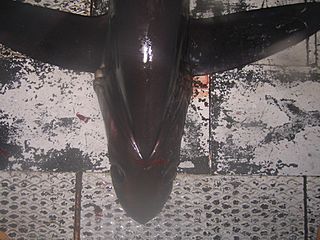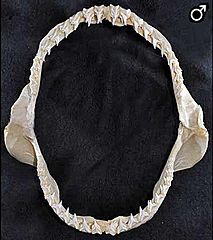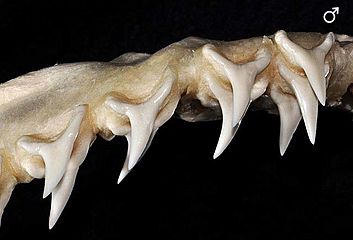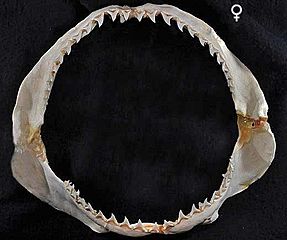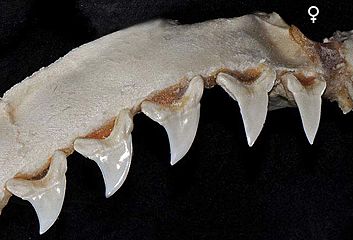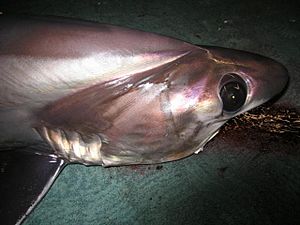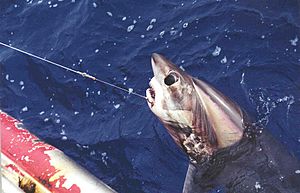Bigeye thresher facts for kids
Quick facts for kids Bigeye thresher |
|
|---|---|
 |
|
| Conservation status | |
| Scientific classification | |
| Genus: |
Alopias
|
| Species: |
superciliosus
|
 |
|
| Range of the bigeye thresher | |
| Synonyms | |
|
Alopecias superciliosus R. T. Lowe, 1840 |
|
The bigeye thresher (Alopias superciliosus) is a type of thresher shark found in warm and cool oceans around the world. Like other thresher sharks, almost half of its total length is its very long tail fin. Its name comes from its huge eyes, which are shaped like keyholes and can even look upwards! You can also spot this shark by two deep grooves on top of its head.
The bigeye thresher's large eyes help it hunt in dim light. It's one of the few sharks that moves up and down in the water each day. It stays in deep water during the day and comes closer to the surface at night to find food. To protect its sensitive brain and eyes from temperature changes, this shark has a special system of blood vessels. It mainly eats fish and squid, which it stuns with whip-like strikes of its long tail. Bigeye threshers give birth to live young, usually two pups at a time. The baby sharks eat unfertilized eggs from their mother while still inside her. This shark is caught by fishermen for its skin, fins, and liver oil. It is considered a Vulnerable animal by the International Union for Conservation of Nature (IUCN).
Contents
About the Bigeye Thresher Shark
Naming and History
A British scientist named Richard Thomas Lowe was the first to describe the bigeye thresher shark in 1840. He studied a shark caught near Madeira in the eastern Atlantic Ocean. For a while, people forgot about Lowe's description, and the shark was known by other names. But in the 1940s, its original scientific name was brought back. The name superciliosus comes from Latin words meaning "above" and "eyebrow," which refers to the grooves above its eyes.
Scientists have studied the bigeye thresher's genes and found that its closest relative is the pelagic thresher shark. Fossils of the bigeye thresher have been found in Japan, showing that this shark has been around for about 16 million years!
Where Bigeye Threshers Live
Bigeye threshers live in tropical and temperate oceans all over the world. In the western Atlantic Ocean, they are found from New York down to Florida, the Caribbean, and parts of South America. In the eastern Atlantic, they live near Portugal, Madeira, and along the coast of Africa, including the Mediterranean Sea. They are also found in the western Indian Ocean near South Africa and Madagascar. In the Pacific Ocean, you can find them from southern Japan to Australia, New Zealand, Hawaii, and off the coasts of California and the Galápagos Islands.
These sharks usually live over the continental shelf (the edge of the land under the sea) and in the open ocean. Sometimes, they come into shallow coastal waters. They prefer water temperatures between 16 and 25 degrees Celsius (61-77°F). However, they can dive very deep, sometimes as far down as 723 meters (2,372 feet), where the water is only about 5 degrees Celsius (41°F). We don't know much about how far they travel, but one shark was tracked moving 2,767 kilometers (1,719 miles) from New York to the Gulf of Mexico.
What Bigeye Threshers Look Like
The eyes of an adult bigeye thresher can be up to 10 centimeters (4 inches) wide. Each eye is taller than it is wide and bulges out. Their eye sockets reach the top of their head, allowing them to look upwards. They also have two clear grooves that run from above their eyes to over their gill slits, making their head look a bit like it's wearing a helmet.
Their snout (nose) is fairly long and rounded. The shark has moderately large teeth with a single, narrow point. They have about 19-24 teeth in their upper jaw and 20-24 in their lower jaw.
The long upper part of their tail fin makes up almost half of their body length. Their large pectoral fins (side fins) are curved and have wide tips. The first dorsal fin (top fin) is placed further back on their body compared to other thresher sharks. Bigeye threshers are usually a deep, shiny violet to purplish-brown on top and creamy white underneath. This color fades quickly to gray after they die. Most bigeye threshers are 3.3 to 4.0 meters (11-13 feet) long and weigh around 160 kilograms (350 pounds). The biggest one ever recorded was 4.9 meters (16 feet) long and weighed 364 kilograms (802 pounds)! It was caught in New Zealand in 1981.
Bigeye Thresher Behavior
Daily Life and Hunting
The bigeye thresher's large, upward-pointing eyes help it find prey by looking for their shapes against the dim light above. This shark performs a daily vertical migration. During the day, it stays in deeper water (300-500 meters or 980-1,640 feet deep) where the water is colder. At night, it swims up to shallower water (less than 100 meters or 330 feet deep). This movement likely helps them find food at night and avoid predators during the day. During the day, they swim steadily, but at night, they slowly rise and quickly dive.
Larger sharks and marine mammals might hunt bigeye threshers. They can also have parasites like copepods and tapeworms. Sometimes, sea lampreys attach themselves to these sharks.
What Bigeye Threshers Eat
The bigeye thresher has bigger teeth than other thresher sharks and eats a wider variety of food. They eat schooling fish like mackerel and herring, fish that live near the bottom like hake, larger pelagic fishes (fish that live in the open ocean) like lancetfish, and squid. They probably use their long tails to stun their prey before catching them. Sharks are often found hooked by their tails on fishing lines, with bait fish in their stomachs. The shape of their eye sockets gives them binocular vision (seeing with both eyes at once) when looking up, which helps them aim their tail strikes better. In the Mediterranean Sea, they are often found with schools of frigate mackerel, suggesting they follow their food. Some people say the bigeye thresher even uses its tail to hit down birds!
Life Cycle
Like other mackerel sharks, bigeye threshers give birth to live young. They usually have two pups, one in each uterus. Sometimes, they might have one, three, or four pups. There isn't a specific breeding season; adult females can be pregnant throughout the year. The length of their pregnancy is not known.
The baby sharks first get food from a yolk sac. Later, they eat unfertilized eggs produced by their mother while still inside her. The unborn pups look like miniature adults, but with bigger heads and eyes. They are covered in a thin layer of skin that protects the mother's uterus from their sharp skin denticles. This special skin layer has not been seen in other thresher shark pups.
Young bigeye threshers are about 1.35 to 1.4 meters (4.4-4.6 feet) long when they are born. Males become adults when they are about 2.7 to 2.9 meters (8.9-9.5 feet) long and 9-10 years old. Females become adults when they are about 3.3 to 3.6 meters (10.8-11.8 feet) long and 12-14 years old. These sharks are thought to live for about 19 years for males and 20 years for females. A female bigeye thresher is estimated to produce only about 20 young in her entire life.
Body Temperature
Scientists are still debating whether the bigeye thresher can keep its body warm, like the common thresher shark. Some studies in the past suggested they could raise their body temperature slightly. However, more recent studies found that while they have muscles that can generate heat, these muscles are located differently than in other warm-bodied sharks. Also, they don't have the same special blood vessel system in their body to keep that heat in.
However, the bigeye thresher does have a very developed blood vessel system around its brain and eyes. This system is believed to protect these sensitive organs from big temperature changes. This is important because the shark moves up and down the water column every day, experiencing temperature shifts of as much as 15-16 degrees Celsius (27-29°F).
Bigeye Threshers and Humans
Bigeye thresher sharks are rarely seen by divers and are not considered dangerous to humans. However, they are caught by fishermen in many countries, including the United States, Japan, Spain, and Brazil. They make up about 10% of the sharks caught in the open ocean. Off the coast of Cuba, they are a significant catch, often attracted at night using chemical lights. Taiwanese fisheries also catch about 220 metric tons of these sharks each year.
The meat of the bigeye thresher is sold fresh, smoked, or dried and salted, but it's not highly valued because it can be mushy. Their skin is used for leather products, their liver oil for vitamins, and their fins for shark fin soup.
In the United States, these sharks are often caught by accident in fishing gear like longlines, gillnets, and trawls. They are also sometimes caught in shark nets near beaches in South Africa. Along with other thresher sharks, the bigeye thresher is a popular game fish for recreational anglers in the United States, South Africa, and New Zealand.
Because bigeye threshers have so few babies in their lifetime, they are very sensitive to overfishing. All three thresher shark species were listed as Vulnerable by the International Union for Conservation of Nature (IUCN) in 2007. In New Zealand, however, the Department of Conservation has classified the bigeye thresher shark as "Not Threatened."
See also
 In Spanish: Zorro de anteojos para niños
In Spanish: Zorro de anteojos para niños



